by blogediter | May 29, 2019 | Chimney Plugs
Where to Measure a Heatelator Pre-Fab Fireplace
Jason, I have a fireplace in our basement that I want to plug since we do not use it.
There is a metal damper that operated on a hand crank just 3″ above the fireplace opening. However, about 14″ above the damper is an 11″x11″ terra cotta flue tile that I think I can easily get a Chimney Balloon into. The website instructions say to buy a Chimney Balloon that is a little large…should I get a 15×15 or 12×12 Chimney Balloon and should I buy a HEK extender with it? – RW
Dear RW, You sized up this application well and your instinct is right-on to go with a 12×12 with a HEK Extender.
11″x11″ is a very common size flue tile, and experience tells me that a 12×12 Chimney Balloon is the perfect size to plug that flue. Since your flue tile terminates just 14″ above the damper then you can certainly use a HEK extender to get it up there and installed. I have attached some pictures that are similar to your install. – Jason
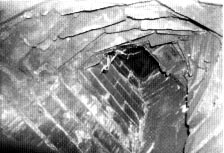
by blogediter | May 27, 2019 | Chimney Plugs
Q: Following the instructions on this site our place for a Chimney Balloon would be roughly 4 feet above the metal damper in a space that is roughly 12×12. I am planning to purchase a 15×15 Chimney Balloon, but is there a HEX extension long enough for placement and inflation of the Chimney Balloon?- RM
A: Dear RM, It sounds like you are trying to size a Chimney Balloon in your first chimney tile area. We do make 36″ long custom HEK Extenders, but I think you will find it much easier to measure and install a Chimney Balloon in a lower location if possible.
What you are looking for in your flue is an area about 7″ or 8″ in height that has roughly parallel walls on at least 2 opposing sides, and is out of the way of the damper hardware.
Knowing that description, is there an area just above or below your damper that may be a better location to measure? Call us at 608-467-0229 for a little more guidance. – Jason
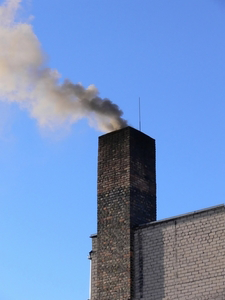
by blogediter | May 6, 2019 | Chimney Plugs
Q: Jason, My house has a standard colonial Chimney made in 1796. What size chimney do i have and what size Chimney Balloon should I use? – JS
A: Dear JS, Unfortunately, there is really no way I can estimate a size Chimney Balloon you would need without seeing the application or having some measurements of the flue. There were certainly no codes or standard sizes for 1796 fireplace construction. It really would be necessary to measure the flue first.
If this is not something you are comfortable with doing, any handymen service or chimney sweep would be capable of doing the measurement. Often times customers will hire a Chimney Sweep to do a chimney cleaning and request that the Chimney Sweep measure for a Chimney Balloon while they are there doing the cleaning. If you wish to do it yourself, you will find a very useful reference at our Chimney damper and flue sizing page: http://www.chimneyballoon.us/Chimneyballoonsizing.html
If you want a little more assistance you can email photos of the fireplace and flue area and I can give you more direction on specifically where to measure. You will be looking for a location in the flue to measure that is within arms reach and has roughly parallel walls. Let me know if I can be of further assistance. – Jason
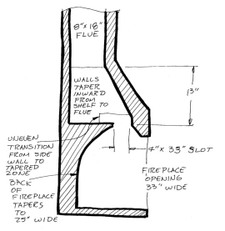
by blogediter | May 3, 2019 | Chimney Plugs
Q:Jason, My fireplace chimney is very unusual since the flue is so far forward and the smoke shelf or smoke chamber is so deep. There is no place to put the Chimney Balloon that has parallel walls before the 8×18 tile flue. Do you see any options that may be easier to install in according to my diagram? – JA
Dear JA: This is not an easy install since your lowest point with parallel walls will be the flue tile above the smoke shelf. Looks like the 18″x 8″ location would be best with an HEK extender handgrip. The smoke shelf juts out so much that the CB handgrip would get in the way of it, if trying to put the CB into the chamber just above the smoke shelf. – Jason
Note: In this case, a Custom 18×8 with an HEK extender worked very well and was easy to install since the flue was only 13″ above the smoke shelf ledge.
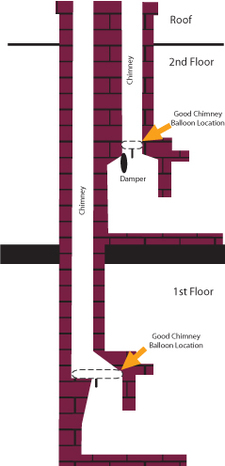
by blogediter | May 1, 2019 | Chimney Plugs
Q: Jason, We have a fireplace upstairs and one directly below it downstairs. Sometimes when we use one fireplace the other one will be smoky. Do we need more than one chimney pillow, or can we even use a chimney pillow in this situation? – LK
A: LK, When you have a fireplace that is one above another the two hearths usually have separate flues and dampers and they run to the roof in the same chimney structure. See the diagram of the two fireplaces sharing a chimney structure.
When you are using one fireplace and chimney your home is drinking in air from other places to allow enough airflow to feed the fire and to draft the smoke and heat upwards out the flue. The home will suck in air from the path of least resistance which is usually the other unused chimney (even if the damper is closed). This draw of air into the house is known as the “stack effect”.
So when the other chimney sucks in air from the roof it also sucks back in some smoke from the other fireplace chimney.
The solution to this problem is to use 2 separate Chimney Balloons, one for each flue. When you have a fire in one of the fireplaces then remove that Chimney Balloon in the used fireplace and leave the other one in place in the unused fireplace. This will force your home to find another less-smoky place to draw from, like doors or windows. – Jason
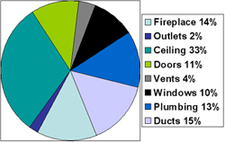
by blogediter | Apr 22, 2019 | Chimney Plugs
Q: Jason – I see in some places on the chimney balloon website and in literature you state that a Chimney Balloon can save a homeowner $200 in home heat. How do you get that figure? – JP
A: Dear JP, I’m glad you ask this. A person should always challenge marketing claims of any product. Lets take a look at what the Department of Energy, the Energy Information Administration, and some independent studies say…
Open or Missing Fireplace Dampers:
A European research study titled “Ventilation perturbations due to an open fireplace in a house” – by P. Dalicieux and C. Nicolas concluded that a missing or left open fireplace damper can result in a home to have a 30% increase in heating costs. The US Energy Information Administration said that in 2005-2006 the average US family spent $1044 on home heating bills. This information is on their 2005-2006 report. So 30% of $1044 is $313. Keep in mind this is 2005-2006 information and energy cost trends have home heating cost increasing 25%-30% each year since then. As you can see, $313 is more than our more conservative statement about $200 in savings using a Chimney Balloon. But, lets look at another study…
Fireplace Dampers That are Functional or Damaged:
The Department of Energy (DOE) states that 14% of a homes heat loss is lost through the fireplace even when there is a damper in the fireplace. They also say the average family in 2005 spends $1600 per year on utility bills. Personally, I think this figure is low. I live in a tight 1100 sq ft ranch (with new power vent furnace and water heater) and I know I spent more than $2000 on utilities in 2007, but I suppose the DOE is figuring in the North and South US climates together.
So if we spend the $1044 per year on home heat that the (The US Energy Information Administration says we spend) and 14% goes up the fireplace flue, then the person is loosing $146 in home heat per year even if you have a functional damper.
So with these two studies we take the average between the two to be $230 in home heat. That is where we get our $200 in heat savings. I hope you can pardon us for rounding down on the final figure. – Jason




